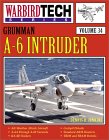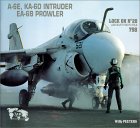The A-6 Intruder was the world’s first fully all-weather attack bomber capable of detecting and identifying both tactical and strategic targets, and delivering both conventional and nuclear ordnance on them under zero-visibility conditions. This extremely accurate, low-altitude, long-range, subsonic aircraft is powered by two turbojet engines partially buried in its plump fuselage. While the A-6 Intruder may not win any beauty contests, it excels in its assigned mission. The A-6 is capable of carrying all U.S. and NATO air-to-ground weapons in its five external store stations — a total payload of 18,000 pounds.
The A-6 is manned by a crew of two, pilot and bombardier-navigator, seated side by side. To assist them, the all-weather navigation and weapons delivery system provides an integrated electronic display which allows them to “see” targets and geographical features regardless of the effects of darkness or foul weather. Due to this ability, the A-6 has often been used as a pathfinder for other types of attack aircraft, allowing their use under conditions which would not normally permit a successful mission.
The A-6A first entered service in February 1963 with VA-42. The A-6B, whose primary job was the suppression of surface-to-air missiles, was basically an avionics modification of the A-6A with provisions for the Navy’s anti-radiation missile. The A-6C, born of the South East Asia war, incorporates electro-optical sensors to observe and attack vehicles moving under cover of darkness.
The A-6E, the last model in the series, features a multi-mode radar and an improved computer. The A-6 Intruder has been the mainstay of the Navy and Marine Corps air arms for more than three decades. It has been constantly improved upon over this time span and has been used for close-air-support, interdiction, and deep-strike missions. It is configured for both Harm and Harpoon missiles and with its radar and FLIR/laser systems, can detect, classify and attack a full range of targets.
The United States Navy replaced their A-6E Intruder’s with F/A-18 Hornets.
| Country of Origin | USA. |
|---|---|
| Similar Aircraft | Hunter. |
| Crew | Two. |
| Role | US Marine Corps all-weather attack bomber, tanker. |
| Armament | Bombs, missiles. |
| Dimensions | Length: 54 ft, 7 in (16.64 m). Span: 53 ft (16.15 m). |
A-6 Intruder WEFT Description
| Wings | Mid-mounted, swept-back, and tapered with blunt tips. |
|---|---|
| Engine(s) | Two turbojets mounted on body midsection. Semicircular air intakes below and forward of the wing roots. Exhausts are in the trailing edges of the wing roots. |
| Fuselage | Teardrop-shaped with a rounded nose. Body tapers to the rear section. Bubble canopy. |
| Tail | Unequally tapered tail fin with a square tip and small, stepped fairing in the leading edge. Swept-back, tapered tail flats, high-mounted on the fuselage with blunt tips. |
Countries which Fly the A-6 Intruder
USA.
A-6 Intruder Manufacturer Web Site
Books on the A-6 Intruder

Grumman A-6 Intruder: WarbirdTech Volume 33
The very capable Intruder was the mainstay of the carrier attack force for almost 30 years.
Coverage includes all attack and tanker variants, detailed coverage of the little-known A-6B and A-6C variants, standard ARM and Shrike shooters, Composite Wing details, and advanced A-6F coverage. For military and aviation enthusiasts and modelers.

Lock On No. 20 : A-6E, KA-6D Intruder, EA-6B Prowler
This twentieth installment in the popular LOCK ON series focuses on the lines and details of the USN A-6E, KA-6D Intruder, and EA-6B Prowler built by Grumman. Stunning full color photography captures such details as the cockpits, landing gear, airframe, engines, wing-folds, flaps, slats, external tanks and pods, air brakes, and general carrier operations of this aging but potent aircraft. This book belongs in the collections of scale modelers, aviation enthusiasts, and USN veterans.

Angles of Attack : An A-6 Intruder Pilot’s War
Moments after Desert Storm began, bomber pilot Pete Hunt was in the air over the Persian Gulf. Hunt saw it all, and this is his electrifying account. Tested to the max, flying all night, every night for weeks on end, Hunt executed dozens of missions - from carpet bombing to dropping deadly five-hundred-pound cluster bombs with pinpoint precision; from supporting Marines on the ground to bombing fleeing Iraqis along the blood-soaked “highway of death.”
His A-6 jet was a wide-open target for the blazing antiaircraft fire streaking up to destroy it. Escaping this deadly blizzard of fire made setting the A-6 back down on a little deck in a big ocean seem almost easy. But Hunt, like the rest of his squadron, the VA-145 Swordsmen - honored as the premier Attack Squadron in the United States Navy for 1991 - was just doing his job: keeping America free.
